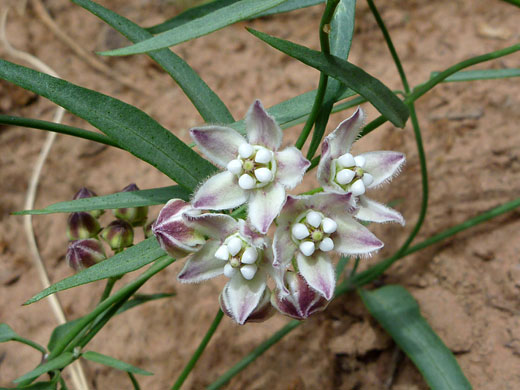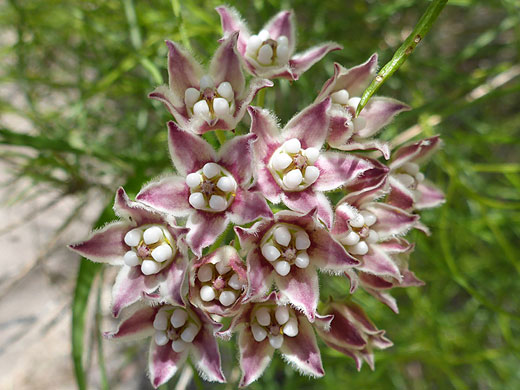Funastrum Cynanchoides, Climbing Milkweed
Plants > Wildflowers > Apocynaceae > Funastrum Cynanchoides

Five-petaled flowers of funastrum cynanchoides ssp hartwegii, in Hellhole Canyon, Anza Borrego Desert State Park, California
Common name:
Climbing milkweed
Family:
Scientific name:
Funastrum cynanchoides
Synonym:
Sarcostemma cynanchoides
Main flower color:
Range:
South California, eastwards to Texas and Oklahoma
Height:
Up to 3 feet
Habitat:
Washes, canyons, hillsides, disturbed and/or cultivated areas, in deserts or semi-deserts; to 5,500 feet
Leaves:
Variable; linear, lanceolate or ovate, up to 3 inches long; wider, often cordate at the base
Season:
April to September
Funastrum cynanchoides is a vine; the long, narrow stems wind often round each other, or adjacent vegetation, and bear many leaves, somewhat variable in shape, from narrow and linear to wider and ovate, cordate at the base. Like all milkweeds, the stems exude a milky sap if cut. Leaves and stems may have a very sparse covering of short hairs, pressed against the surface.
Flowers have five small, triangular sepals and five larger, spreading petals, mostly pink or purple but white along the edges. The symmetric flower center is formed of five white appendages, separate from the base of the corolla, and five light brown anthers, around a greenish filament column which has a two-lobed pistil at the top. Petal edges are fringed. Flowers form compact spherical clusters.
Ssp hartwegii (narrowleaf climbing milkweed) has linear or narrowly lanceolate leaves, while the slightly less common ssp cynanchoides (broadleaf climbing milkweed) has wider, triangular or cordate leaves.
Flowers have five small, triangular sepals and five larger, spreading petals, mostly pink or purple but white along the edges. The symmetric flower center is formed of five white appendages, separate from the base of the corolla, and five light brown anthers, around a greenish filament column which has a two-lobed pistil at the top. Petal edges are fringed. Flowers form compact spherical clusters.
Ssp hartwegii (narrowleaf climbing milkweed) has linear or narrowly lanceolate leaves, while the slightly less common ssp cynanchoides (broadleaf climbing milkweed) has wider, triangular or cordate leaves.
All Contents © Copyright The American Southwest | Comments and Questions | Contribute | Site Map






